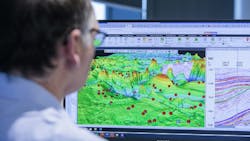Report addresses groundwork challenges for UK North Sea carbon storage, offshore wind expansion
Offshore staff
ABERDEEN, UK — The newly published "Seismic Imaging within the UKCS Energy Transition" report by the North Sea Transition Authority (NSTA) assesses the role technology can play in carbon capture and storage (CCS) and offshore wind in the UK North Sea.
To date, Britain’s government has issued 21 carbon storage licenses, and the NSTA estimates that up to 100 will be needed to meet CO2 sequestration targets.
Carbon storage sites will require redevelopment of large parts of the UK basin. According to the report, the options for characterizing the subsurface for both carbon storage and offshore wind include deploying techniques originally developed for the oil and gas industry and adapted for new purposes.
While some, such as streamer seismic, may be the most cost-effective, the downside is a larger footprint and difficult application in developed areas. Increasingly, the authors say, there will be a need to choose techniques that can minimize operational footprints of individual projects (i.e., ocean-bottom seismic); improve resolution; make the best use of early baseline data; and exploit improvements in processing and also passive signals, removing the need for extensive operations.
As sharing marine space becomes more important, there will be an increased need for discussions on how to manage competing demands for space. These can be supported by sharing knowledge and databases, a process that the UK Energy Technology Platform, the Offshore Energy Digital Strategy Group and the National Data Repository are already working on.
Adrian Topham, CCUS & Hydrogen technical lead at The Crown Estate, said, “The Crown Estate is committed to building that body of evidence, through our pioneering work to digitally map existing and future demands on the seabed out to 2050 and through the Offshore Wind and CCUS Co-Location forum established to provide strategic coordination of co-location research and activity and help maximize the potential of the seabed for these two critical activities.”
Professor John Underhill, Aberdeen University’s director for Energy Transition, added, “Carbon storage in subsurface reservoirs in saline aquifers and depleted oil and gas fields provides a means by which to lock in industrial emissions that would otherwise be released into the atmosphere. For sequestration to be successful, it is imperative to select and monitor the best stores to ensure that they are safe and do not leak.
“Crucially, the NSTA report also documents the significant challenges resulting from the competition for offshore areas, particularly where fixed and floating wind farms impede seismic data acquisition. The report is a timely reminder of the urgent need for marine spatial planning to maximize the use of offshore areas, if the country is going to meet its net-zero targets.”
10.10.2023



